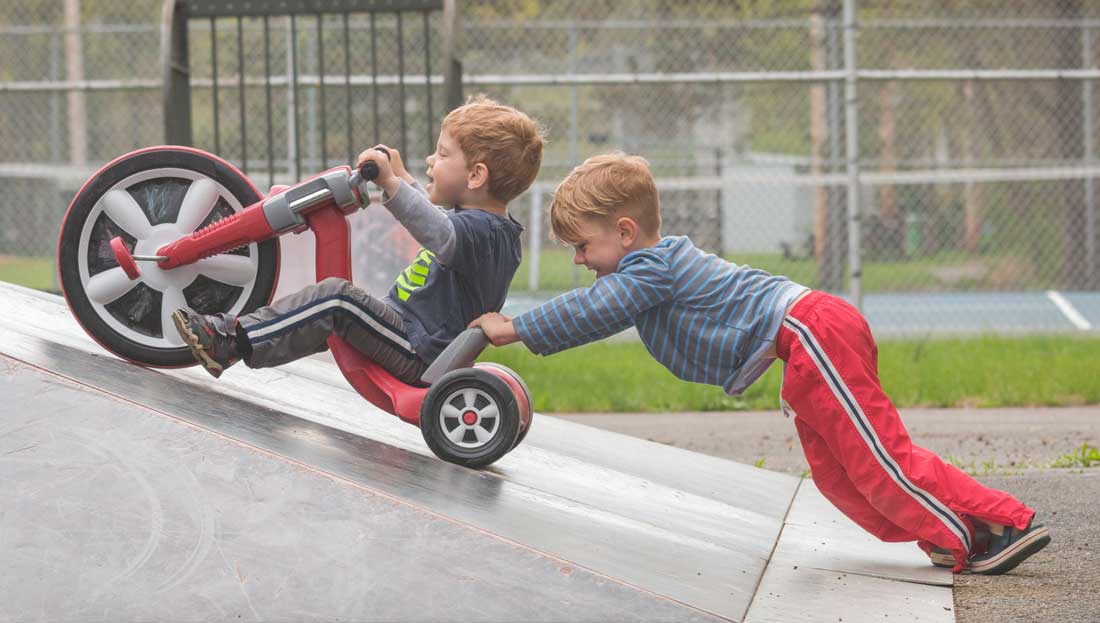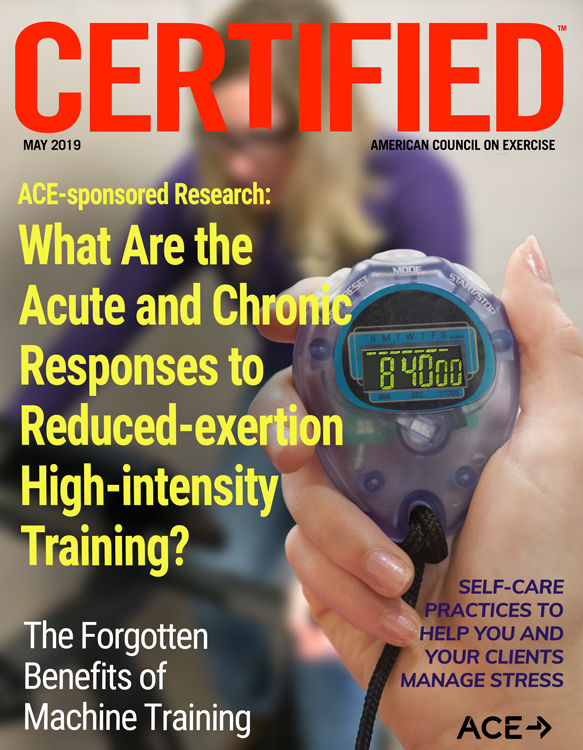
As a health and exercise professional, you can play an important role in supporting and encouraging parents to help their kids be physically active.
As you well know, exercise can help to prevent chronic diseases such as heart disease, as well as strengthen developing bones and muscles. Physical activity also impacts mental health and cognitive development and is associated with decreased risk for depression and improved academic performance (U.S. Department of Health and Human Services, 2018). Unfortunately, although the research is clear that getting an adequate amount of physical activity has endless benefits for kids and teens, only 21.6% of kids and teens meet the recommended 60 minutes of moderate-to-vigorous activity per day.
Despite legal guidelines mandating states to offer physical education in schools, many schools in the U.S. do not require P.E., which means kids have few opportunities to be physically active during the school day. Additionally, kids and teens are using electronic devices for as many as seven hours per day (Rideout, Foehr and Roberts, 2010). Increased screen time at home combined with little-to-no exercise at school means kids and teens are spending a majority of their lives being sedentary rather than staying active, which is a pattern of behavior they are likely to carry with them into adulthood (Varma et al., 2017).
Clearly, it’s more important than ever to promote the importance of physical activity for kids, but we have to focus on more than just the physical benefits.
There is strong evidence that physical activity can promote self-confidence in kids. For example, researchers who conducted a 2016 review of 22 studies examining the relationship between physical activity and mental health concluded that, “The strongest evidence was found for improvements in physical self-perceptions, which accompanied enhanced self-esteem in the majority of studies measuring these outcomes” (Lubans et al., 2016). Self-confidence is crucial for healthy growth and development, sense of self and preventing mental health issues such as depression and anxiety.
How Physical Activity Improves Confidence in Kids and Teens
Following are three evidence-based ways physical activity can improve confidence in kids and teens:
- Skill Building. Physical activity is beneficial in helping kids to develop age-appropriate skills such as balance, jumping and hand-eye coordination (Table 1). When kids have the opportunity to learn and apply skills at a young age, there is less likelihood of “embarrassment” or choosing not to participate when it comes time to practice the skill around their peers (during P.E., for example). When kids have the opportunity to learn at a young age that it feels good and is fun to run around or play a sport, they are more likely to continue to be active for their own enjoyment, rather than feeling forced or persuaded to exercise by parents or teachers.
- Resilience and Mental Strength. When young children are given the opportunity to fall down—off a bike, scooter, skateboard or skis, for example—they not only have a shorter distance to fall, they get used to falling and trying again. While younger kids are more likely to be enthusiastic or interested in trying something new, once adolescence hits, increased social pressure makes many kids feel more conscious of others’ judgments (real or perceived). Learning to lose in sports can also provide valuable life lessons about handling disappointment and not giving up. Losing games, falling off bikes and missing catches are all a normal part of playing sports and being active, and can be “transferable skills” to other areas of life, such as getting a bad grade or not getting a part in a play.
A 2017 meta-analysis of 50 studies found strong evidence that physical activity “is associated with decreased concurrent depressive symptoms” (Korczac, Madigan and Colasanto, 2017). When kids are feeling good and mentally healthy, they are more likely to want to try new things. This can trigger a healthy cycle of feeling good, which increases their desire to exercise more, which in turn increases their confidence.
- Family Support. A parent’s role in modeling healthy behavior is crucial. A 2018 study found that parents’ physical-activity habits were associated with higher levels of physical activity in adolescents, even after controlling for confounding factors (Christofaro et al., 2018). Family activities involving exercise (such as swimming, biking or taking walks together) can also improve family relationships. Additionally, a 2017 study found that even when parents are not particularly active, the family relationship and support is a big indicator of success with the child making healthy changes (Nock et al., 2016).
When physical activity is a part of the family’s normal routine and kids see their parents enjoying the benefits of being active, they are more likely to join in and develop their own interests in physical activity.
Just as homework or chores are often a part of the daily routine, parents can facilitate and encourage their kids and teens to get physical activity by scheduling exercise. Replace a chunk of screen time with physical activity for a win-win.
Dr. Natalie Muth, a board-certified pediatrician and registered dietitian, urges the parents of her patients to focus on how much fun physical activity can be. “The bottom line is that we need to build activity into every child’s day and focus on the fun factor,” explains Dr. Muth. “If we do that, we have set the stage for kids to improve both health and academic performance.”
Table 1. Developmental Skills by Age
|
Age
|
Physical Milestone
|
Skill-building Activity
|
|
18 months
|
Pushing, pulling, throwing
|
Rolling a ball back and forth, push toys, playing on playground, playing chase, hide and seek
|
|
2 years
|
Standing on tiptoe, beginning to run, kicking a ball
|
Running, kicking a ball, riding on sit-and-scoot toys
|
|
3 years
|
Climbing, pedaling tricycle, walking up and down stairs, walking backward, jumping off low objects
|
Practice climbing at the park, take family walks or hikes, introduce a trike or bike, play tag, catch and hide and seek, participate in sports or classes such as gymnastics or dance as attention span gets longer
|
|
4 years
|
Hopping and standing on one foot, catching a bounced ball, jumping on small trampoline
|
Balance games, introduce bat and ball, Duck Duck Goose, Simon Says, nature walks, swinging/pumping legs alone
|
|
5 years
|
Standing on one foot for 10 seconds or longer, hopping, may begin to skip, can do a somersault
|
Balance beam, hopping, climbing trees, jump rope, hop scotch, circuit training
|
|
6-7 years
|
Refining coordination, move in time to a beat or music, riding a two-wheel bike, swimming skills
|
Dancing, riding bike without training wheels, stretching/yoga, skateboarding, swimming
|
|
8 + years
|
Hand-eye coordination and attention span improving with age
|
Sports teams, kick ball, swimming, rock climbing
|
How to Help Kids Gain Confidence
Here are five ways health and exercise professionals can help kids gain more confidence in their ability to participate in physical activity. Be sure to pass along this advice to your clients who have kids, as well.
- Encourage kids to do what they enjoy. Unlike adults who may run on the treadmill for 45 minutes even though they don’t love it, kids will not participate or get the full benefit from activities they do not enjoy. For kids to figure out what they do like, they need the opportunity to try a variety of activities. Exposure to many sports and activities early on—through camps, classes or P.E., for example—can help kids identify the activities they enjoy doing. Consider the personality of the child if he or she is hesitant to do something new. For example, an introverted child might not enjoy team sports, but may love the solitude of swimming.
- Focus on helping kids develop age-appropriate skills. Mastering skills such as catching, throwing or sprinting can feel rewarding and improve confidence for kids, and are also crucial for growth and development.
- Encourage families to make fitness a part of their lives. Offer your clients a list of games, body-weight circuits for any age, local hikes or ways families can engage in friendly competition (such as step challenges or a family 5k). Giving them ideas for how they can be active can help them bridge the gap between knowledge and action.
- Be a physical-activity resource for your clients and their families. In many communities, there is no shortage of opportunities for kids to take classes, attend camps or participate in organized sports and activities. Do some research and help connect parents with resources that are available in your community. This may include, for example, rec centers, dance studios, after-school programs or gyms that offer classes geared toward kids and teens.
- Always make sure to frame exercise in a positive way by using body-positive language. For example,
- We get to work out (instead of we have to work out) and are fortunate our bodies are strong and healthy.
- Avoid making weight loss the goal and instead focus on things like getting faster or stronger.
- Our bodies feel happy and energized when we exercise.
- People of all shapes and sizes are great athletes.
- All bodies can play, exercise and have fun.
Whether you work directly with kids or their parents, you can play an integral role in helping every generation experience the benefits of a physically active lifestyle, explains Todd Galati, ACE's Senior Director of Science and Research. "Well-qualified health and exercise professionals have the opportunity to play an important role in their communities by helping people of all ages to live healthier lives and helping the youth of today to become the healthy and physical active adults of tomorrow."
References
Christofaro, D.G.D. et al. (2018). Adolescents’ physical activity is associated with previous and current physical activity practice by their parents. Journal de Pediatria, 94, 1, 48-55.
Korczak, .J., Madigan, S, and Colasanto, M. (2017). Children’s physical activity and depression: A meta-analysis. Pedatrics, 139, 4, pii: e20162266 .
Lubans, D. et al. (2016). Physical activity for cognitive and mental health in youth: A systematic review of mechanisms. Pediatrics, 138, 3, pii: e20161642.
Nock, N.L. et al. (2016). Physical activity self-efficacy and fitness: Family environment relationship correlates and self-esteem as a mediator among adolescents who are overweight or obese. Childhood Obesity, 12, 5, 360-367.
Rideout, V.J., Foehr, U.G. and Roberts, D.F. (2010). Media in the Lives of 8- to 18-Year-Olds. A Kaiser Family Foundation Report.
U.S. Department of Health and Human Services. (2018). Physical Activity Guidelines for Americans, 2nd ed. Washington, D.C.: U.S. Department of Health and Human Services.
Varma, V.R. et al. (2017). Re-evaluating the effect of age on physical activity over the lifespan. Preventive Medicine, 101, 102-108.





 by
by 


